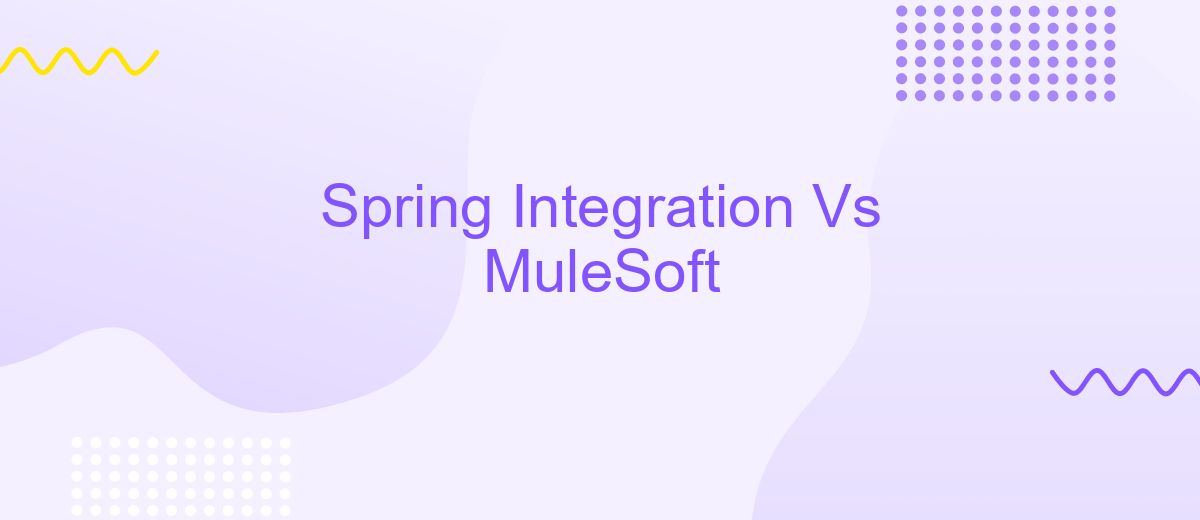Spring Integration Vs MuleSoft
In today's fast-paced digital landscape, integrating disparate systems and applications is crucial for seamless business operations. Two popular integration platforms, Spring Integration and MuleSoft, offer robust solutions for connecting diverse technologies. This article delves into a comparative analysis of Spring Integration and MuleSoft, highlighting their features, strengths, and use cases to help organizations make an informed decision.
Introduction
In today's rapidly evolving technological landscape, businesses are increasingly reliant on robust integration platforms to streamline their operations and enhance productivity. Two prominent solutions in this domain are Spring Integration and MuleSoft. Both platforms offer unique features and capabilities, making it essential for organizations to understand their differences and choose the one that best fits their needs.
- Spring Integration: An extension of the Spring framework, it provides a lightweight solution for enterprise integration patterns.
- MuleSoft: A comprehensive integration platform that offers extensive tools and connectors for various applications and services.
- ApiX-Drive: A versatile service that simplifies the integration process, making it easier to connect different systems without extensive coding.
Choosing between Spring Integration and MuleSoft requires a thorough understanding of each platform's strengths and limitations. While Spring Integration is ideal for those already invested in the Spring ecosystem, MuleSoft offers a more extensive range of connectors and tools. Additionally, services like ApiX-Drive can further simplify the integration process, providing a seamless and efficient way to connect disparate systems.
Key Differences

Spring Integration and MuleSoft are both powerful tools for enterprise integration, but they have key differences. Spring Integration is a lightweight framework that is part of the larger Spring ecosystem, making it ideal for Java developers who are already familiar with Spring. It offers a wide range of adapters and integration patterns, but it requires a good understanding of Java and Spring to use effectively. MuleSoft, on the other hand, is a more comprehensive integration platform that supports a wide variety of protocols and technologies out of the box. It is designed to be more user-friendly, with a graphical interface that allows users to design integrations without writing code.
Another significant difference is in their approach to integration. Spring Integration is more modular and flexible, allowing developers to pick and choose the components they need. MuleSoft provides a more unified solution, with built-in tools for API management, data transformation, and analytics. For those looking for an easy-to-use service to automate integrations without deep technical knowledge, ApiX-Drive can be a valuable resource. ApiX-Drive offers a user-friendly interface and supports a wide range of applications, making it easier to set up and manage integrations without extensive coding. This makes it a strong contender for businesses looking to streamline their integration processes efficiently.
Use Cases and Benefits

Spring Integration and MuleSoft are powerful tools for enterprise application integration, each offering unique use cases and benefits. Spring Integration is ideal for organizations already using the Spring framework, providing seamless integration with other Spring components. MuleSoft, on the other hand, is a robust platform for API-led connectivity, suitable for enterprises requiring extensive API management and connectivity across diverse systems.
- Spring Integration: Best for Java-centric environments, enabling seamless integration with existing Spring applications.
- MuleSoft: Optimal for enterprises needing comprehensive API management and connectivity across various systems and platforms.
- ApiX-Drive: Facilitates integration setup, allowing businesses to automate workflows and connect different applications without extensive coding.
Both solutions offer distinct advantages: Spring Integration excels in environments heavily reliant on Java and Spring, while MuleSoft provides extensive API management capabilities. Services like ApiX-Drive can further enhance these platforms by simplifying the integration process and automating workflows, making it easier for businesses to connect various applications and streamline operations.
Integration Patterns

Integration patterns are essential for designing robust and scalable applications. Both Spring Integration and MuleSoft offer a range of integration patterns that facilitate seamless communication between disparate systems. These patterns help in addressing common integration challenges such as message routing, transformation, and orchestration.
Spring Integration provides a comprehensive set of patterns that are based on the Enterprise Integration Patterns (EIP) book by Gregor Hohpe and Bobby Woolf. MuleSoft, on the other hand, offers a rich library of pre-built connectors and templates that simplify the integration process. Both platforms aim to streamline the development of integration solutions while ensuring high performance and reliability.
- Message Routing: Directs messages to appropriate channels based on specific criteria.
- Message Transformation: Converts messages into different formats to ensure compatibility between systems.
- Message Orchestration: Manages the sequence and coordination of message exchanges across multiple systems.
In addition to these patterns, services like ApiX-Drive can further simplify the integration process by providing a user-friendly interface for configuring and managing integrations. ApiX-Drive supports various connectors and automation rules, making it easier to connect different applications without extensive coding. This can be particularly useful for businesses looking to streamline their workflows and improve operational efficiency.
Conclusion
In conclusion, both Spring Integration and MuleSoft offer robust solutions for enterprise integration, each with its own strengths and unique features. Spring Integration excels in environments where Java is the primary programming language and offers seamless integration with the Spring ecosystem. Its lightweight and flexible framework makes it an excellent choice for developers looking for a customizable and code-centric approach.
On the other hand, MuleSoft provides a more comprehensive platform with a wide range of pre-built connectors and tools, making it ideal for organizations seeking a low-code or no-code solution. Its extensive support for various protocols and data formats simplifies the integration process across diverse systems. For those looking to further streamline their integration workflows, services like ApiX-Drive can be invaluable, offering automated data transfer and integration capabilities that enhance efficiency and reduce manual effort. Ultimately, the choice between Spring Integration and MuleSoft should be guided by the specific needs and technical landscape of your organization.
- Automate the work of an online store or landing
- Empower through integration
- Don't spend money on programmers and integrators
- Save time by automating routine tasks
FAQ
What are the main differences between Spring Integration and MuleSoft?
Which one is easier to use for integrating cloud services?
How do they compare in terms of performance?
What kind of support and community resources are available?
Is there a service that can help with setting up and automating integrations?
Time is the most valuable resource in today's business realities. By eliminating the routine from work processes, you will get more opportunities to implement the most daring plans and ideas. Choose – you can continue to waste time, money and nerves on inefficient solutions, or you can use ApiX-Drive, automating work processes and achieving results with minimal investment of money, effort and human resources.


